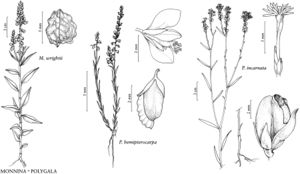Polygala incarnata
Sp. Pl. 2: 701. 1753.
Herbs annual, single-stemmed, (1–)2–4(–7) dm, sparsely branched (rarely from near base); from taproot. Stems erect, glaucous, glabrous. Leaves mostly alternate, sometimes whorled or opposite at lowest 1–2 nodes proximally; sessile or subsessile; blade linear, (3–)4–12(–17) × 0.3–1 mm, base obtuse to acute or slightly cuneate, apex acuminate, surfaces glabrous. Racemes (rarely spikelike), densely cylindric, (0.6–)1–3.5(–4) × 1–1.3 cm; peduncle 2–4 cm; bracts deciduous, ovate to lanceolate-ovate. Pedicels (0–)0.5–1 mm, glabrous. Flowers usually pink to purple, rarely white, sepals pink, 5–8(–10) mm; sepals narrowly ovate to linear-oblong or lanceolate, 0.9–1.5(–2.5) mm; wings narrowly ovate to linear-oblong or narrowly oblanceolate, 1.5–3(–4) × 0.6–1 mm, apex acute to obtuse; keel 5–8 mm, crest 2-parted, with 3 lobes on each side, each 2–4-lobed. Capsules ellipsoid or subglobose-ovoid, 2.4–3.5 × 1.5–3 mm, margins not winged. Seeds 1–2.2 mm, pubescent; aril to 1.1 mm, not obviously lobed, to 1/4 length of seed.
Phenology: Flowering spring–late summer (year-round).
Habitat: Prairies, meadows, savannas, bogs, old fields, open woodlands.
Elevation: 0–400 m.
Distribution
Ont., Ala., Ark., Del., D.C., Fla., Ga., Ill., Ind., Iowa, Kans., Ky., La., Md., Mich., Miss., Mo., N.J., N.Y., N.C., Ohio, Okla., Pa., S.C., Tenn., Tex., Va., Wis., Mexico (Veracruz), Central America (to Nicaragua).
Discussion
Polygala incarnata is the only species in the flora area with the keel two (or rarely three) times the length of the sepal wings. It appears to be relatively rare over much of its range.
Selected References
None.
